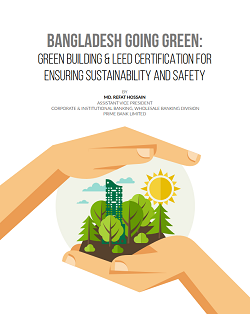
BANGLADESH GOING GREEN: GREEN BUILDING & LEED CERTIFICATION FOR ENSURING SUSTAINABILITY AND SAFETY
MD. REFAT HOSSAIN ASSISTANT VICE PRESIDENT CORPORATE & INSTITUTIONAL BANKING, WHOLESALE BANKING DIVISION PRIME BANK LIMITED
A growing number of people and organizations in Bangladesh are becoming aware of the environment and making environmentally friendly decisions more
than ever. This is undoubtedly a sign that we care about mother nature and for the safety of the building occupants. As a result, Bangladesh has the greenest
knit apparels factory, Plummy Fashions Limited, in the world, and the number of green buildings is on the rise.
Green building is a type of construction that takes into consideration the environment and ensures resource efficiency during the construction period and the
life cycle of the building. It is also considered to be a sustainable building, benefiting the people, planet and increasing profit.
Many organizations certify green building across the globe, considering almost similar factors and guidelines. Prominent names in the industry include :
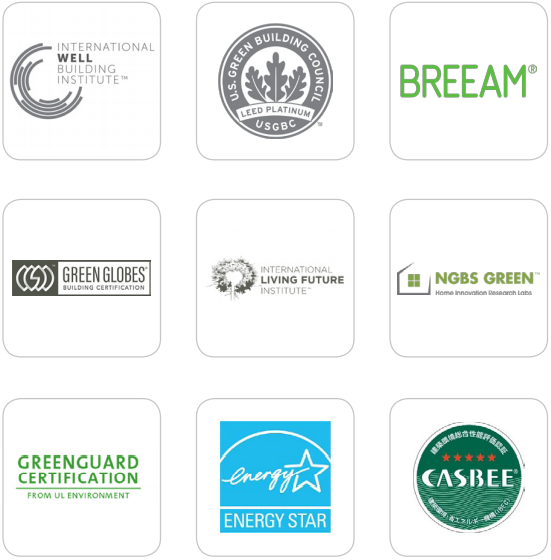
Although all the companies mentioned above have prestigious certifications, LEED is the most used green building rating system in Bangladesh and is widely used in other countries across the globe. This certification process takes into consideration a number of things like a building and its neighborhood’s green features, design, construction, operations, and maintenance. Therefore, understanding the green building features is in line with the LEED.
LEED-certified Green Building features and categories:
LEED stands for Leadership in Energy and Environmental Design, and it is the most widely used green building rating system in the world. All LEED projects have to cover different primary areas by addressing the core features of green buildings. The system has 110 points or credits in total, where at least 40 points are required to be LEED-certified. This organization has four levels of certification for industries, offices, retails, residential, and other building projects.
Four LEED® Certification Levels Based on Credits Earned
Based on the points earned in any green building project, four levels of certifications are possible. These level of certification exhibits how eco-friendly a
building is, where the platinum level is the maximum.
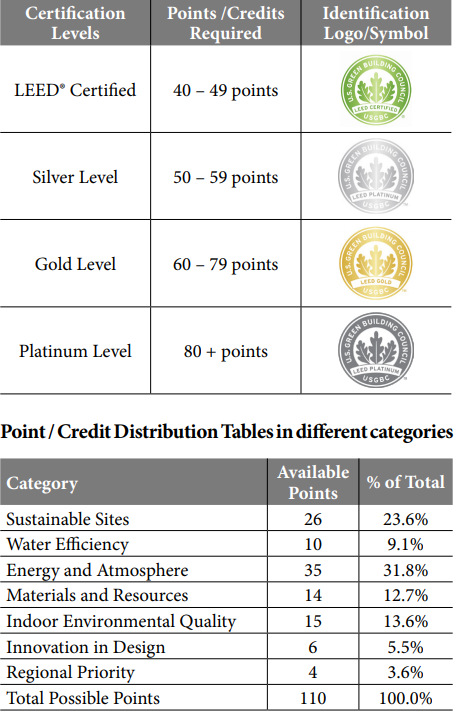
Different Categories in LEED Certification [Latest V4]
The integrative process is an essential concept of sustainable thinking, focusing on connection and communication among all the professionals and stakeholders in a green project. Designing and managing a project efficiently, involving all stakeholders, helps to make better decisions and achieve cost-effective green building outcomes.
The location and Transportation category of LEED, encourages construction on infill or dumped sites. In this way, people can protect open and green spaces. This category rewards thoughtful decisions for the location of a building, a condensed building development can be helpful for transportation, restaurants, parks, grocery stores, and other essential amenities. In this way, a project team can help a city from sprawling unnecessarily.
A sustainable site plan considers the effects of a building on the surrounding environment. The reduction of environmental impacts due to deforestation, soil
erosion, depleted and polluted water resources, and many more harmful effects on the natural system is advantageous. This category provides sustainable site designing strategies which emphasize on restoring the ecosystem and preserving the biodiversity. For example - keeping or planting trees for providing shade, using a proper lighting system to avoid light pollution at night, and thoughtful planning about other issues respecting mother nature.
The water efficiency category has the primary goal of saving potable water. LEED addresses both indoor and outdoor water use. Indoor water use can be reduced through metering, installing low-flow plumbing fixtures, reusing the water-recycled from sinks and showers for bathroom flushing, etc. Outdoor water usage can be decreased by dumping or avoiding sprinklers and planting native and adaptive plants. We have to remember that although 70% of the world is covered with water, only 1% is drinkable.
The principal goal of the Energy and Atmosphere category is to curtail the use of fossil fuels. A project team can earn almost one-third of the total LEED
credits or points. They can attain energy efficiency by using energy and water-saving appliances and renewable energy sources such as solar or wind power.
Optimizing energy performance can save the life cycle cost of the building and the regular expenses of the occupants.
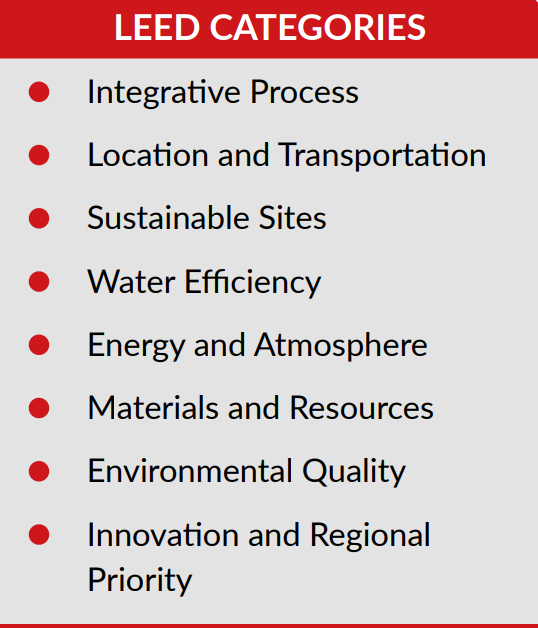
Resources and Materials Category ensures the efficient use of energy and minimizes environmental impacts at the time of extraction, transport, maintenance, and disposal of building materials during the construction and life-cycle of the building. A project must thoughtfully use green materials, such as renewable materials, recycled materials, and natural materials. Furthermore, a project team should decide to collect the resources or materials from the proximity of the construction area to reduce time, transportation cost, and the use of fossil fuel.
The building occupants’ health and comfort are taken into account in the environmental category of LEED. So, this section addresses indoor design and
environmental factors strategically. Quality of light and air inside the building, acoustic structure, and ability to control these surroundings generally influence thepeople who live or work in a building. Proper ventilation system, tobacco smoke control, use of low emitting materials in paints and coatings, adhesive and sealants, flooring systems, thermal comfort, and effective use of daylight are critical in planning a quality environment in a building.
Innovative design strategies and Regional Priority are considerations for the future. Sustainable design strategies are ever-evolving, therefore, the purpose
of this LEED category is to recognize projects for innovative building features, practices, and strategies. In line with its own innovation, the building project
team can also use the LEED-Pilot Credit Library of USGBC (U.S. Green Building Council) to exploit new ideas in a proposed building project. Regional
Priority is also crucial in designing a project because geographical conditions, resource availability, and construction laws vary from country to country. So,
some good practices in the United States might not be acceptable in Bangladesh.
LEED Certification Process
LEED certification has a simple four-step process. It starts with registering a project through LEED online by completing key forms and paying a registration fee.

Then, the project team applies for LEED certifications with all necessary documents claiming the LEED credits. In the process, it is essential to upload the
documents in the system like relevant prerequisite/credit information, clearly labeled file attachments, and concise narratives to describe project-specific circumstances. Fee payment is also applicable in this step for the application.
The review process is usually done in three phases – Preliminary Review, Final Review, and Supplemental Review. For each, GBCI usually responds in 20-25
working days, however, the timeline may be higher during this epidemiological situation.
In the end, the certification takes place, and it is a time to celebrate. It is time to accept the results to confirm the prestigious LEED certification. Once the final application review is complete, a project team can either accept or appeal GBCI’s final review report or request an additional supplemental (appeal) review too.
LEED Certification Cost Structure:
Each project is unique based on design, use, and many other factors, therefore, the LEED certification expense varies based on the project’s rating system
and size. According to the USGBC, the cost of LEED certification breakdown is as follows:
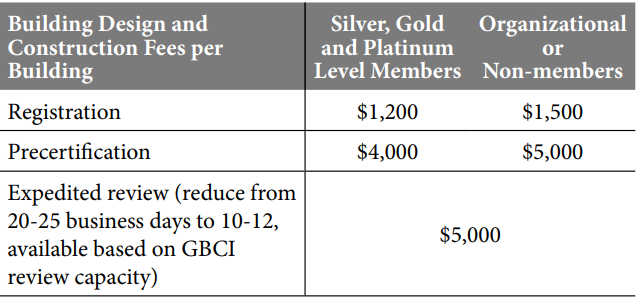

Additional costs might be involved specific to expedited reviews, credit appeals, formal inquiries, and/or hiring a sustainability advisor or consultant. To calculate an estimated certification cost online, please visit: https://www.usgbc.org/tools/leed-certification/pricing-tool
LEED Certified Greed Buildings & Global Practice:
LEED is global now. In 160 countries and territories, 79,000 participating projects are covering over 15 billion square feet as stated on the USGBC website. On February 13, 2019, U.S. Green Building Council declared the top 10 countries for LEED Green Building. Although the popularity of LEED-certified buildings is growing across the world, the United States still maintains the leading position in the number of projects and space.
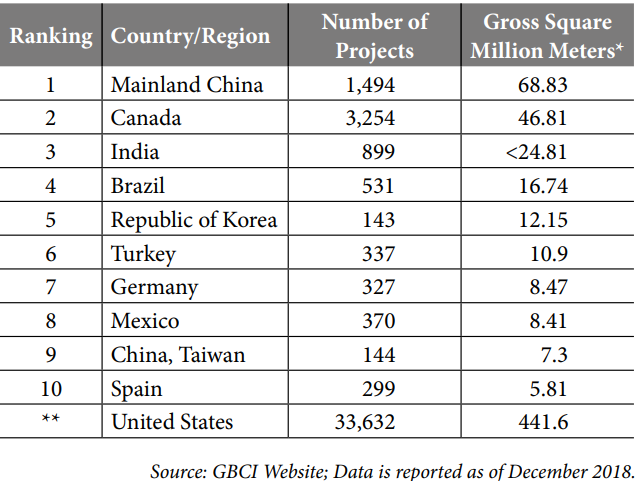
Globally, there are many rating tools available to certify a green project. Based on a LEED Certification system the following rating tool needs to be complied
for an eco-friendly project (BD+C: New Construction and Major Renovation category).
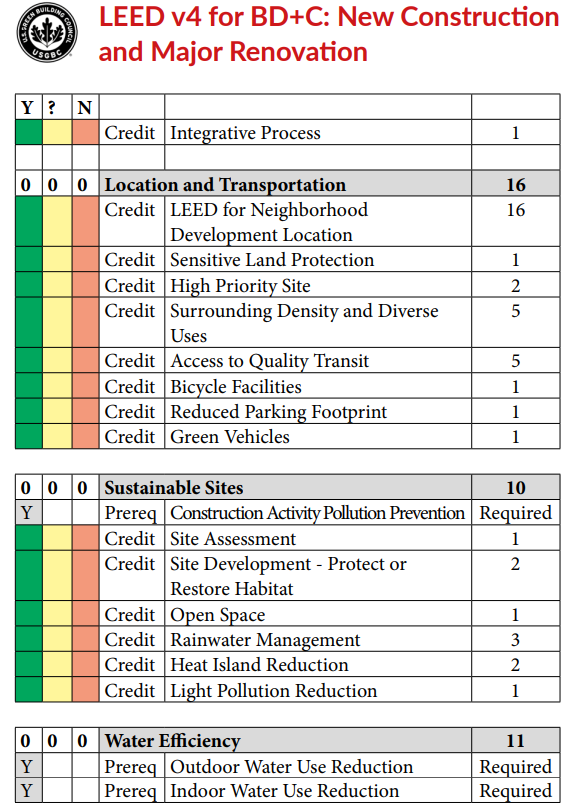

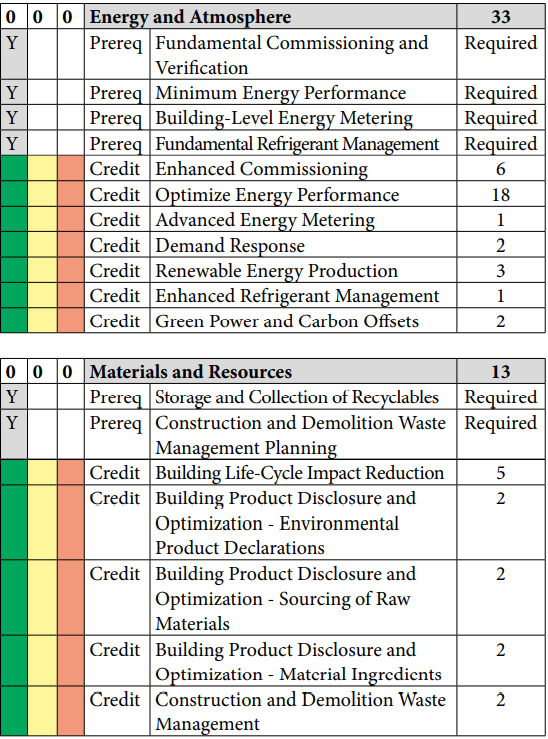

![]()
Bangladesh Going Green:
In Bangladesh, the green projects continue to grow as the industrialists have become more concerned about the environment, and they understand the lifecycle cost of a green building. As per USGBC data, Bangladesh had only one LEED Certified project in 2011, whereas there are more than 160 LEED-certified green projects in 2021. Also, there are more than 400 registered organizations whose construction or certification is under process. The statistics show the demand for green projects in Bangladesh.

People have become climate-conscious, which led them to build and maintain projects that are using less energy and water, supporting sustainable development, and reducing their carbon footprint. So, they are not only helping Bangladesh reduce emissions but also combating climate change which is a part of the Global Sustainable development goals.
Top Three (3) Green Projects in Bangladesh Based on LEED Score:

Low-Interest Loan/ Financing Options in Bangladesh for Green Projects:
Banks and NBFIs in Bangladesh, stood up to fund eco-friendly projects or green buildings for various purposes. Apart from that, different low-interest rate financing for green construction projects is also available from the Central Bank – Bangladesh Bank.
Under the refinancing scheme of Bangladesh Bank’s Sustainable Finance Department, the following options are available:

Besides, Green Transformation Fund and SREUP Financing Scheme (Program to Support Safety Retrofits and Environmental Upgrades in the Bangladeshi Ready-Made Garments Sector) also offer loans for green building projects in various capacities for longer terms with loan moratorium facilities.
SREUP project is largely focused on three areas – (1) Safety Retrofits, (2) Social Upgradation, and (3) Environmental Upgradation.

Under each category, green building transformation, and new environment-friendly constructions’ fund sourcing is possible. However, only fashion (RMG) industry clients of Bangladesh can solely enjoy the facility. After a successful project completion, this financing option also offers 10%-20% range grants, based on the project categories. Since the lenders also receive a portion of the grants, they are equally interested as borrowers to this financing.
Many institutional clients have been benefitted from enjoying these low-cost funds. Many banks and financial organizations help to connect with Bangladesh Banks’ relevant departments to help serve their customers better and enjoy the facilities from Bangladesh Bank’s.
If the funding options increase, the number of green building projects might grow in large numbers. In short, the sustainable fund can boost sustainable buildings in the future.
Major Challenges & Way Forward:
The main obstacle to more green projects is that they are perceived to be expensive. Most people still think that green projects are costlier than the regular projects, but the actual scenario is different. Green projects cost similar to the regular projects if planned at an earlier stage of building design and development. These projects can even cost less when the building life cycle expenses are considered.
People have to comprehend the truth about the green projects and consider their eco-friendly features. The more we learn about it, the more interested will we be to support green structures, because they will be better for our planet and our future generations.
The lack of experts in this field is also a major challenge. There are not many professionals trained in green technologies across the globe. However, awareness is rising among the new generation of professionals, and this category of work is demanding and individually satisfying, so the number of professionals is also likely to grow globally
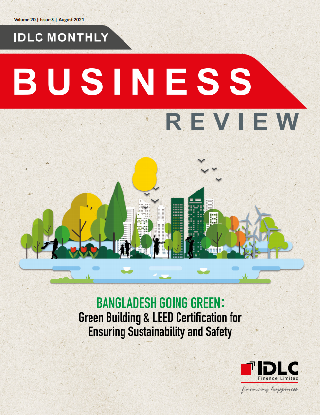
BANGLADESH GOING GREEN: GREEN BUILDING & LEED CERTIFICATION FOR ENSURING SUSTAINABILITY AND SAFETY
Green Building and LEED Certification: One of the many attempts to ensure sustainability in Bangladesh.
The spiraling concern for saving the environment and its resources has led many platforms to opt for the green building strategy, which takes into account
the environmental factors and efficient distribution of limited resources. Bangladesh has also stepped up in the initiative of Green building strategy, and at present Plummy Fashions, of Bangladesh, is thegreenest knit apparel factory in the world awarded by USGBC ( U.S. Green Building Council). Amongst the
numerous Green Building rating systems available, LEED certification is the most widely used rating system worldwide, as well as in Bangladesh.
Leadership in Energy and Environmental Design (LEED) has 110 credits in total, and consists of 4 levels of certification for industries, offices, retails, residential, and other building projects. LEED Certified buildings are on the rise globally, with the USA occupying the leading position in terms of projects and space. The LEED Certification process consists of four simple steps, starting with registering for a project online through their website.
Within a short time, the number of LEED-certified projects has risen above 160 in Bangladesh, this has led multiple banks and NBFIs, including Bangladesh
Bank, to come up with several financing schemes to help finance the green construction projects. Besides these, Green Transformation Fund and SREUP Financing Scheme (Program to Support Safety Retrofits and Environmental Upgrades in the Bangladeshi Ready-Made Garments Sector) have also come up with initiatives, specific to the RMG industry, to finance green building. Thus, these initiatives have allowed many clients to benefit from the low-cost funds.
With the availability of more funding options and awareness, there can be an upsurge in the number of green building projects in Bangladesh. With climate
change being one of the most heated issues in the contemporary world, it is time to train more experts in this field so that the new generation of professionals will understand the significance of the issue.
Bonnishikha Chowdhury
Executive Officer
IDLC Finance Limited